Tài liệu Kỹ năng đàm phán của luật sư Quantcast
Đàm phán là việc hai hay nhiều bên thảo luận và thương lượng với nhau
nhằm đạt tới một sự thỏa thuận về một vấn đề nào đó, điều mà sau đó có
thể trở thành hiện thực hoặc thậm chí không trở thành hiện thực được
(không đạt được thỏa thuận và đàm phán thất bại).
PHẦN I. LÝ LUẬN VỀ ĐÀM PHÁN
1. Khái niệm
Đàm phán là việc hai hay nhiều bên thảo luận và thương lượng với nhau
nhằm đạt tới một sự thỏa thuận về một vấn đề nào đó, điều mà sau đó có thể
trở thành hiện thực hoặc thậm chí không trở thành hiện thực được (không đạt
được thỏa thuận và đàm phán thất bại).
Đàm phán có lịch sử lâu đời (việc thương lượng để trao đổi với nhau những
thứ săn bắn, hái lượm được của thời tiền sản xuất hàng hóa )
Đàm phán được thực hiện trong nhiều lĩnh vực khác nhau của đời sống xã hội
loài người.
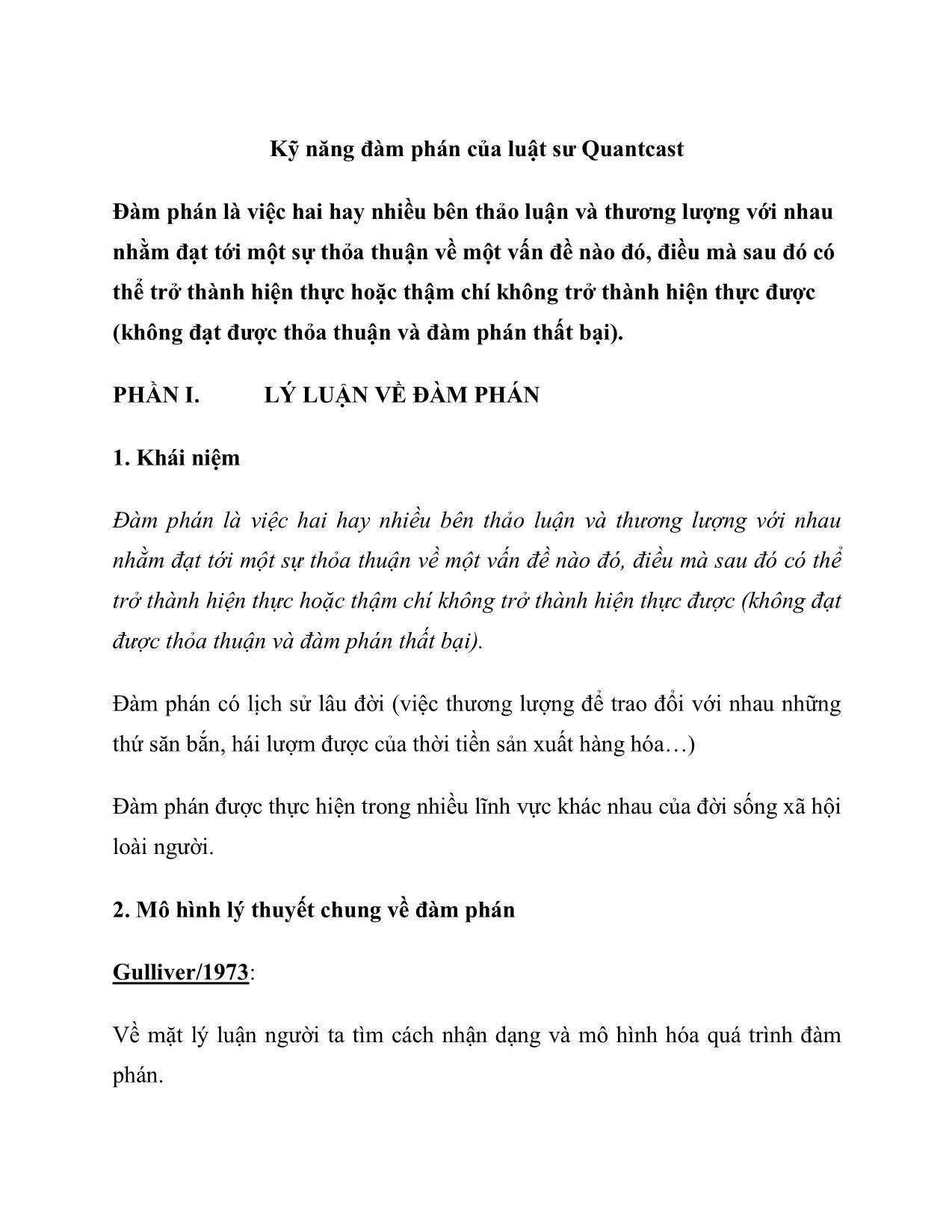
Trang 1
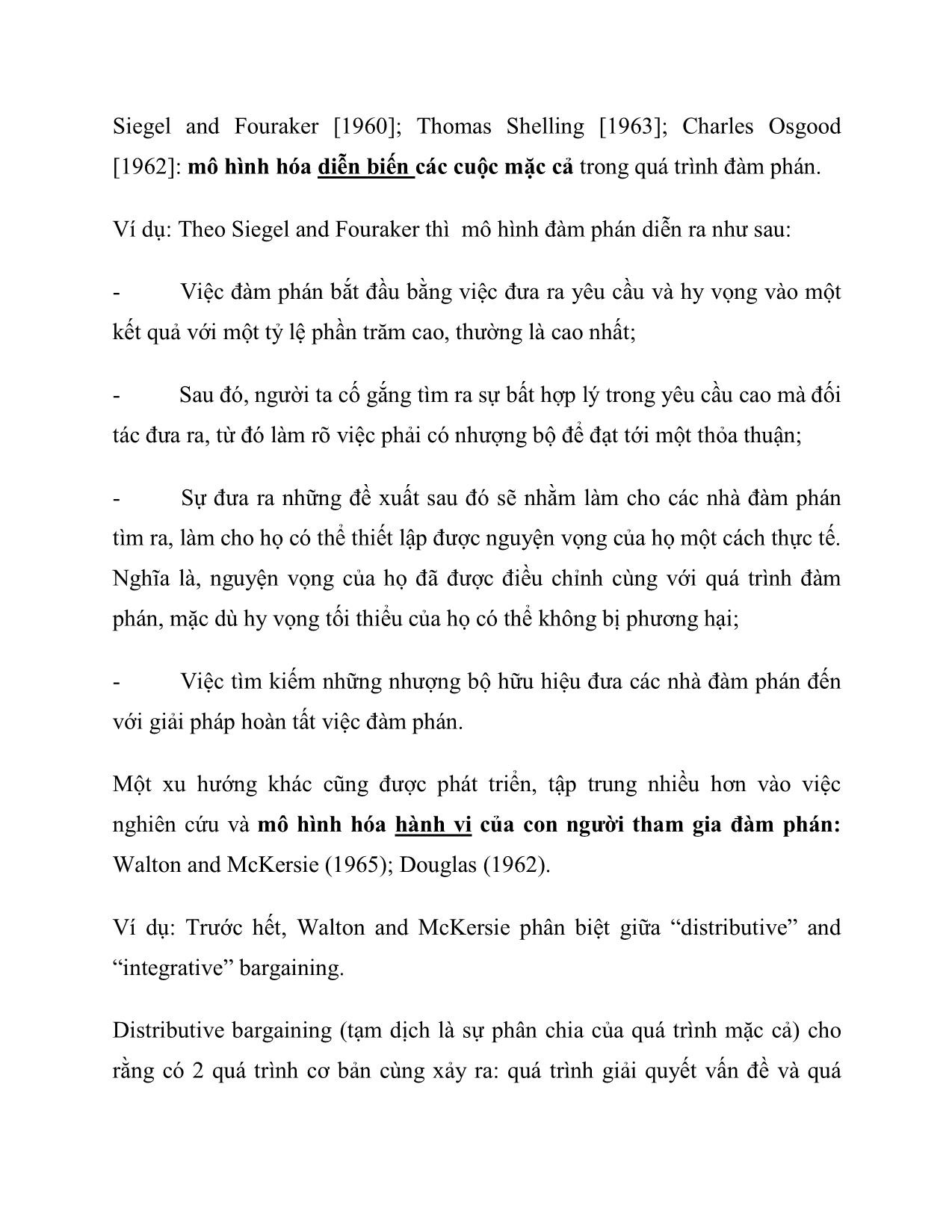
Trang 2
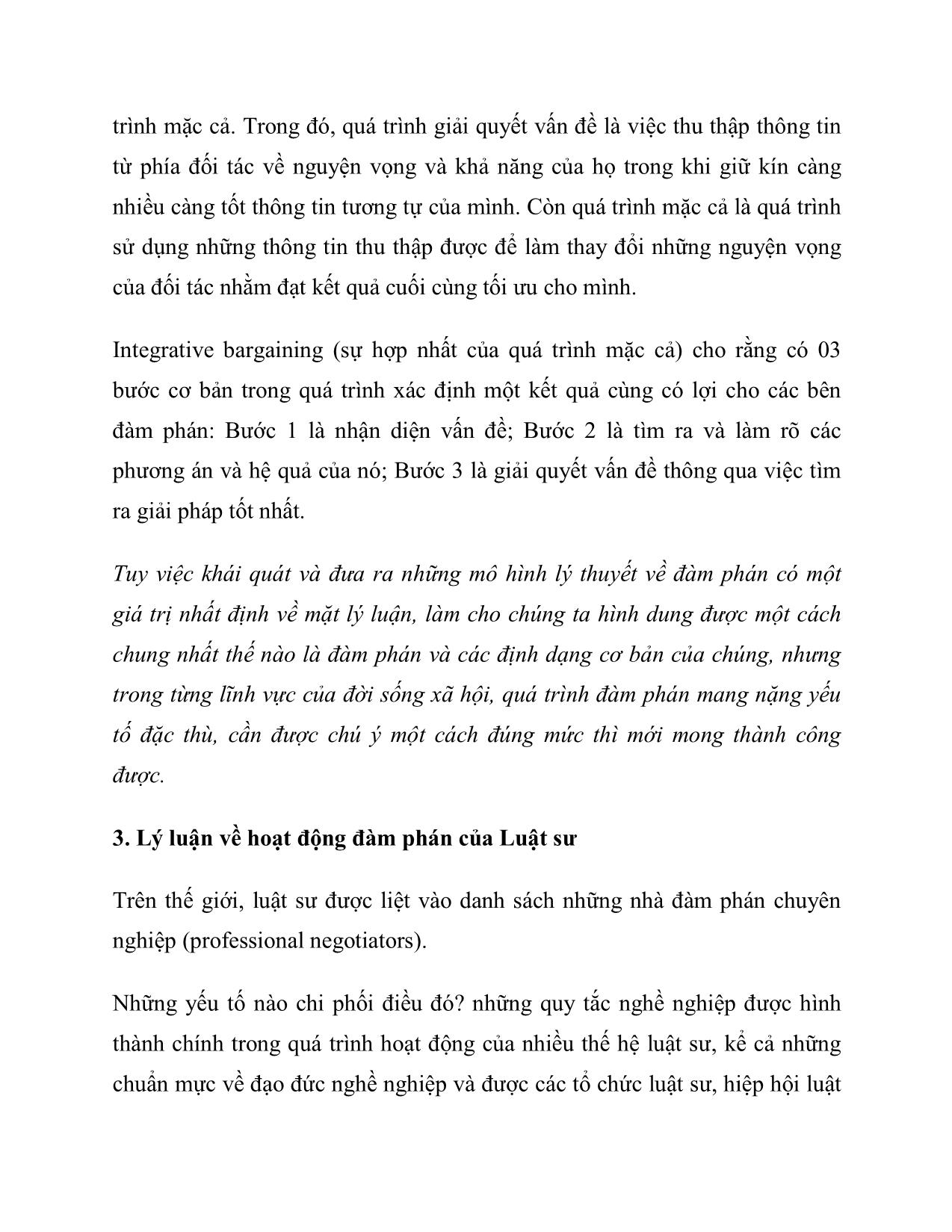
Trang 3
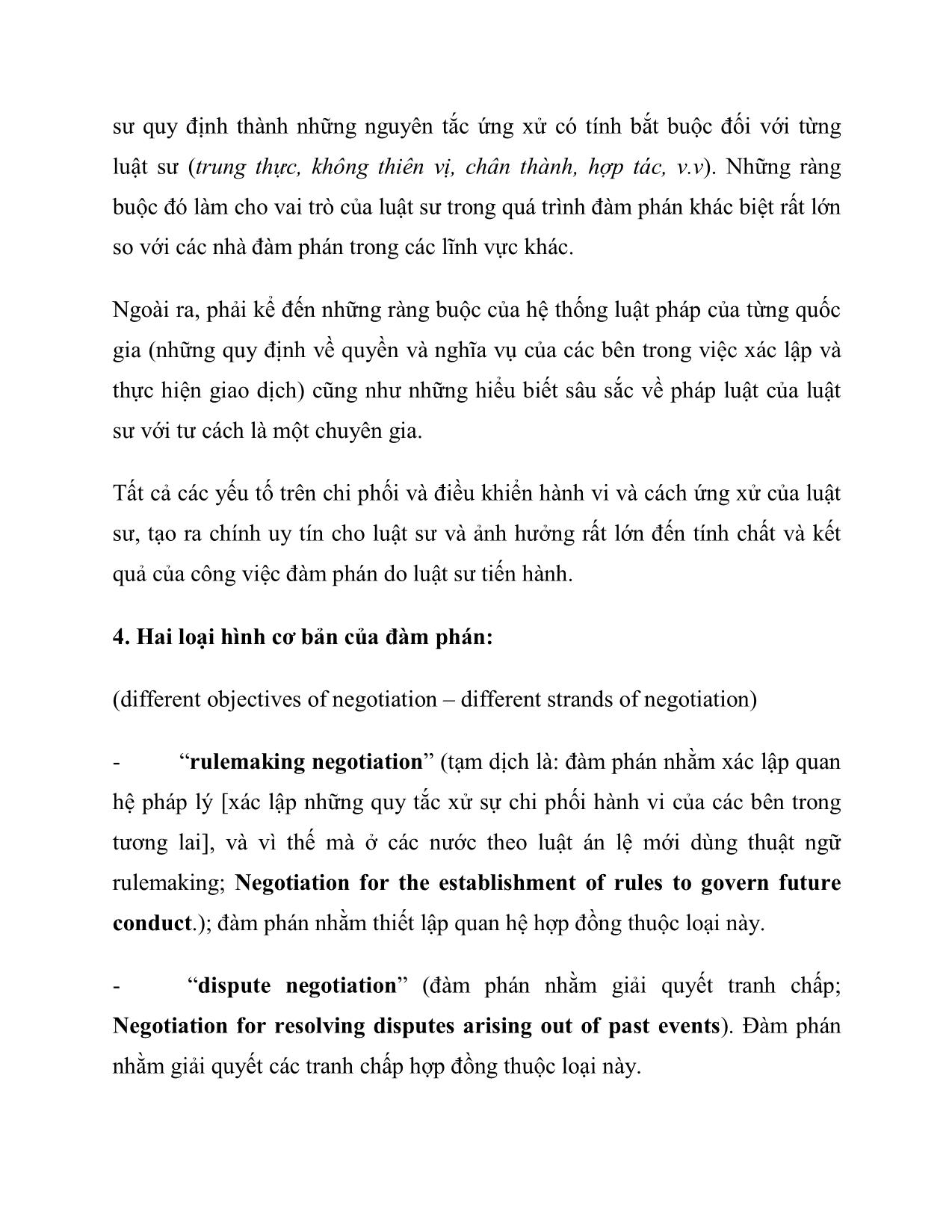
Trang 4
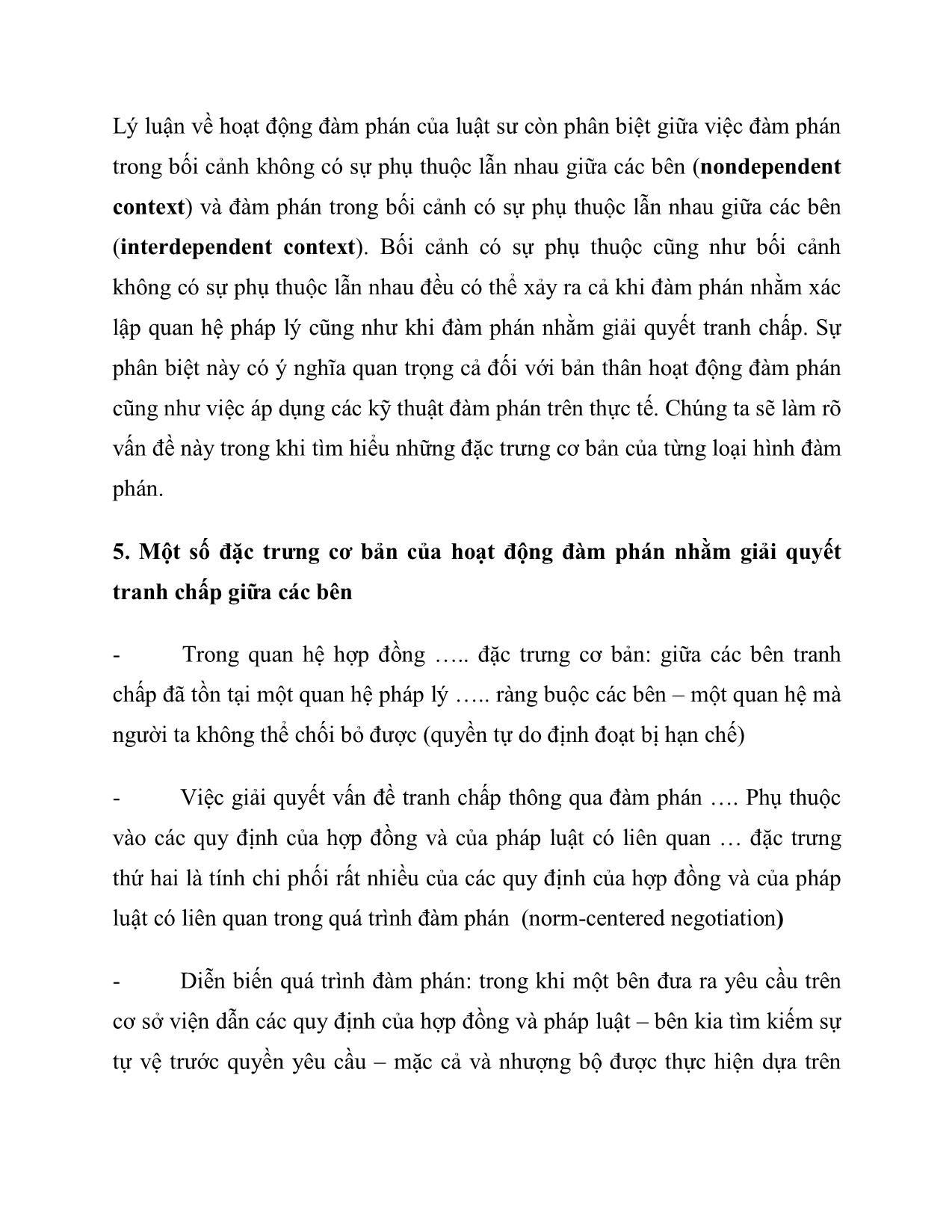
Trang 5
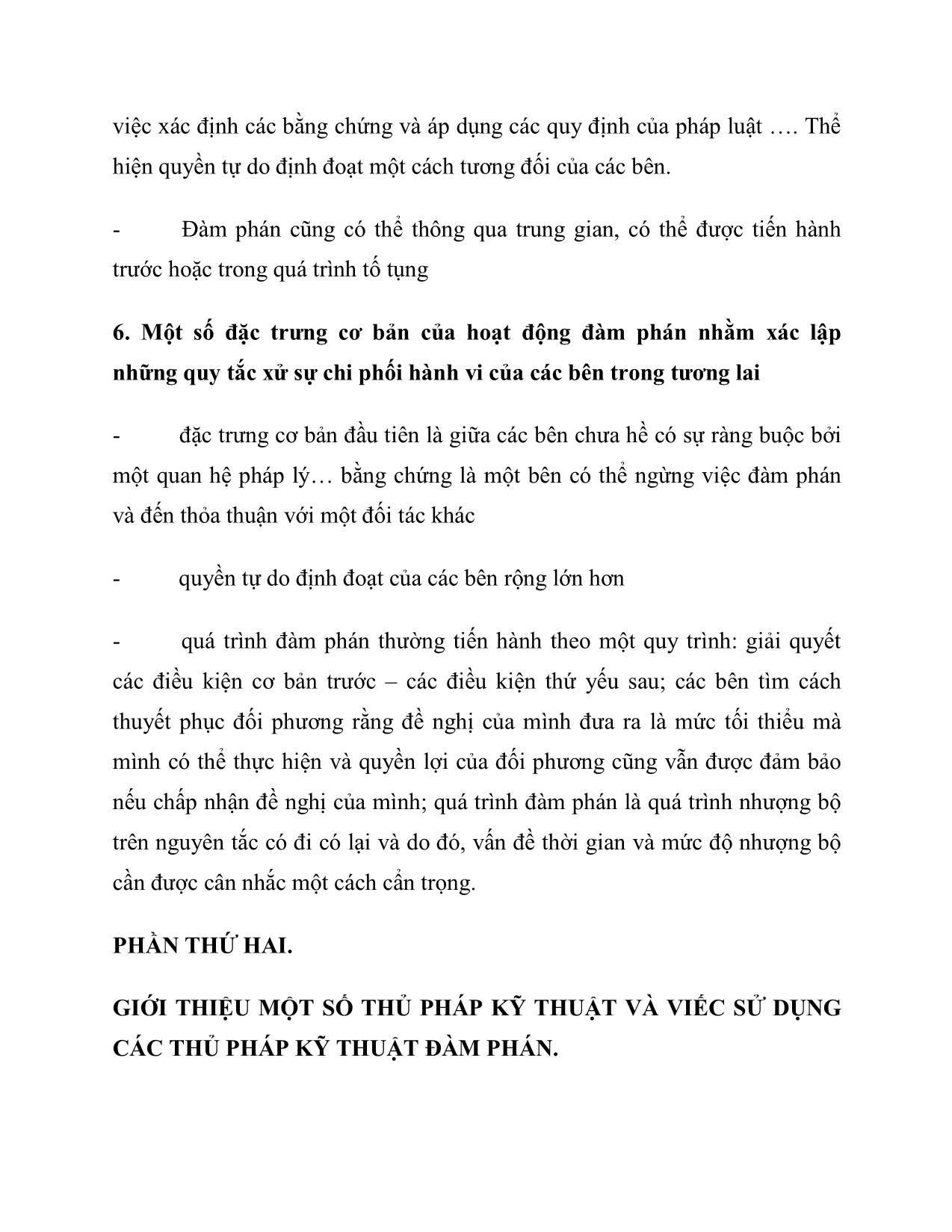
Trang 6
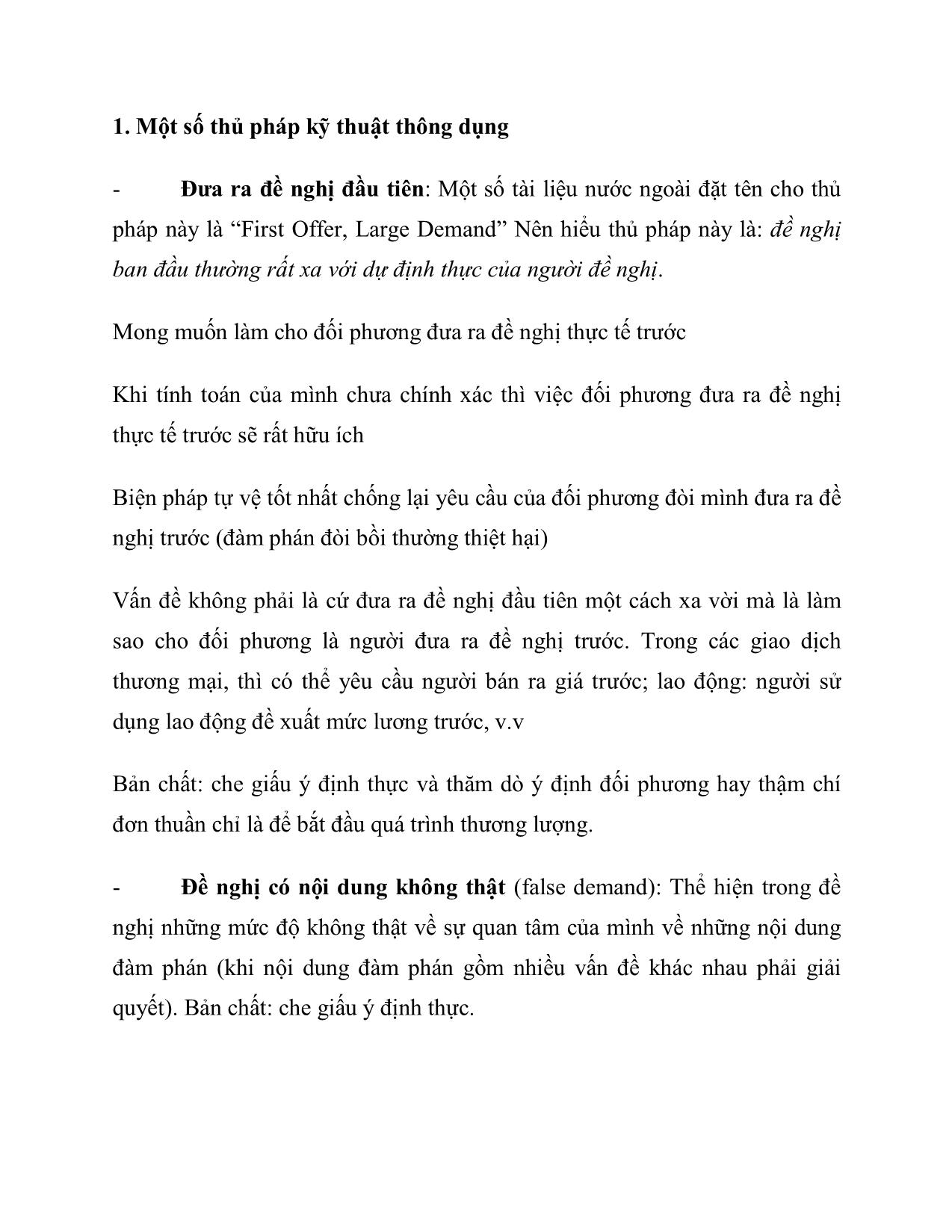
Trang 7
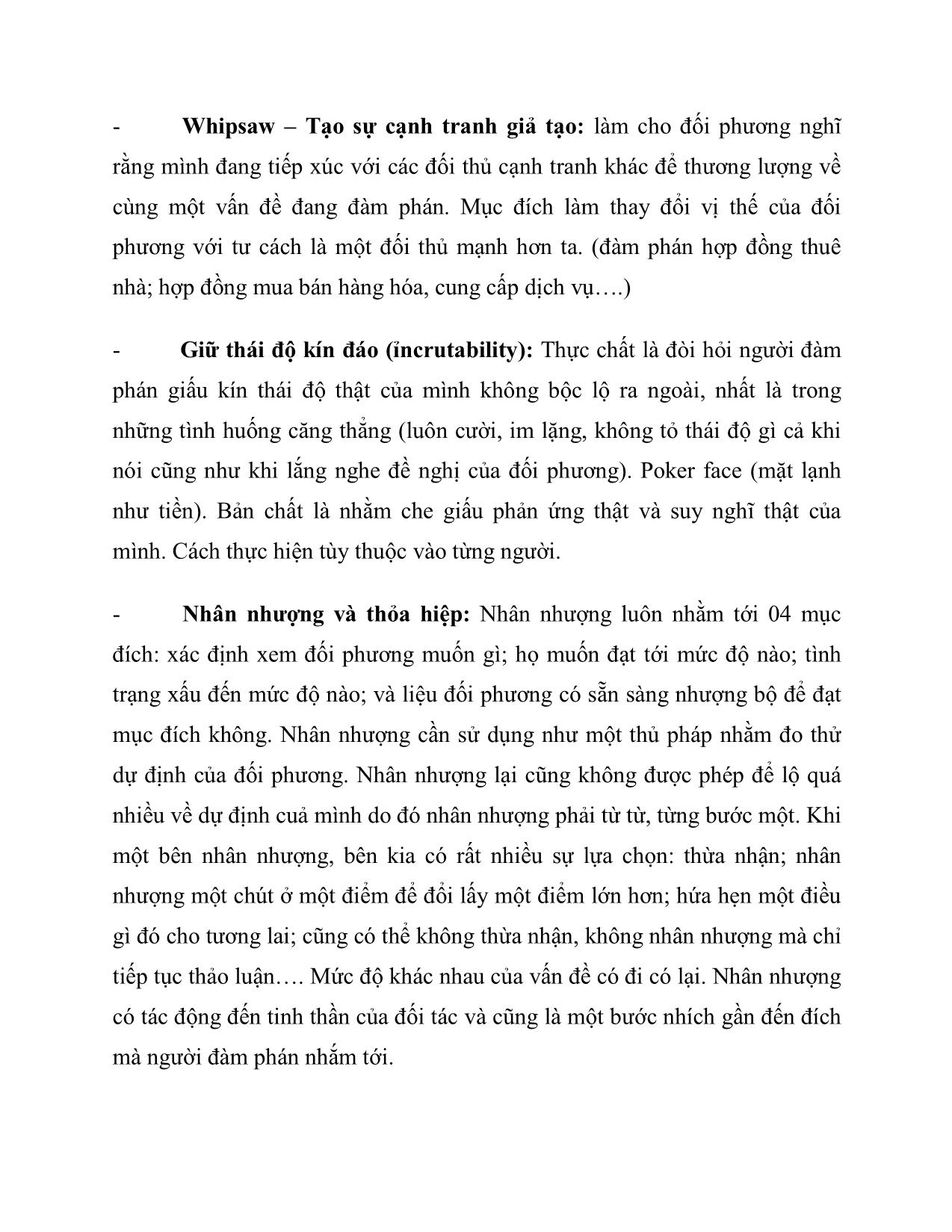
Trang 8
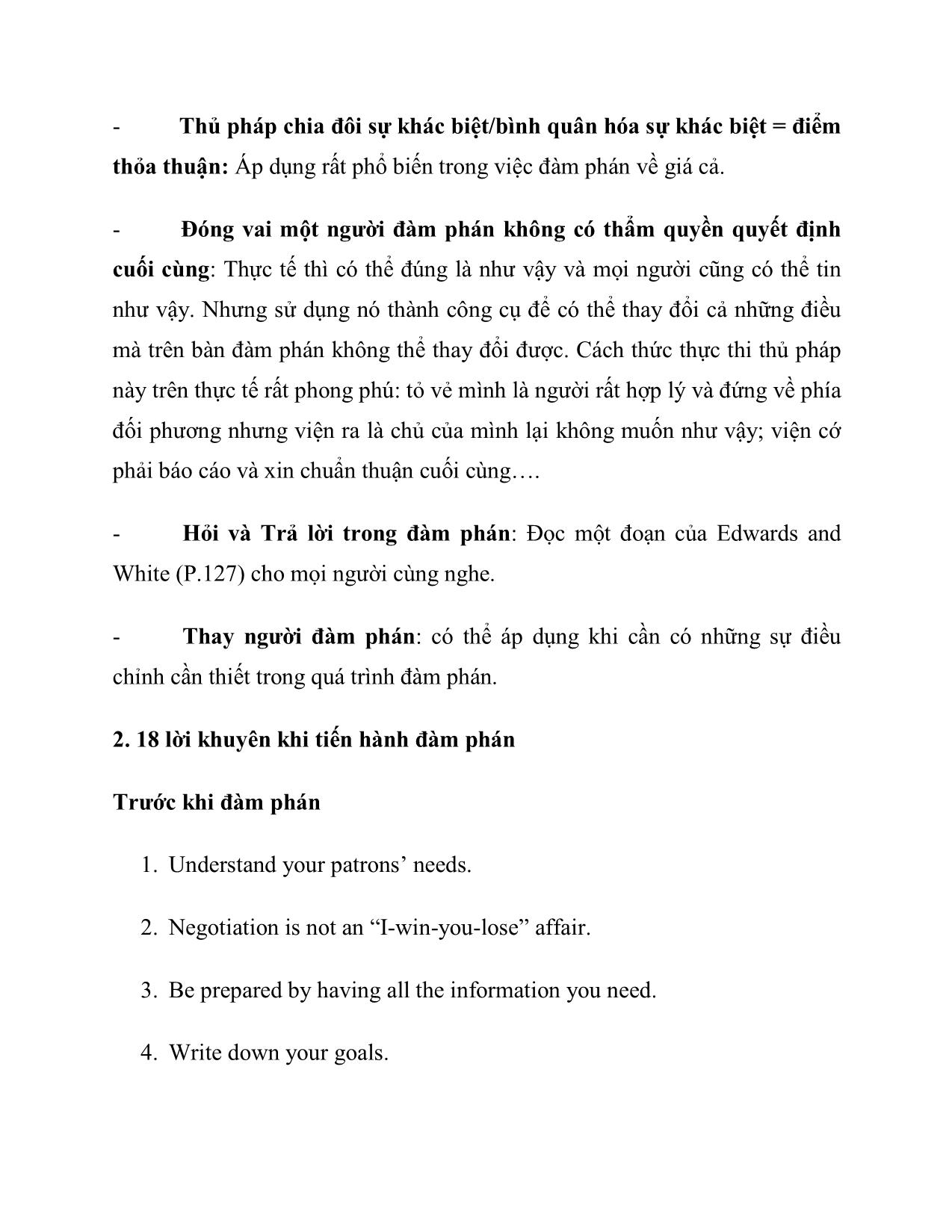
Trang 9
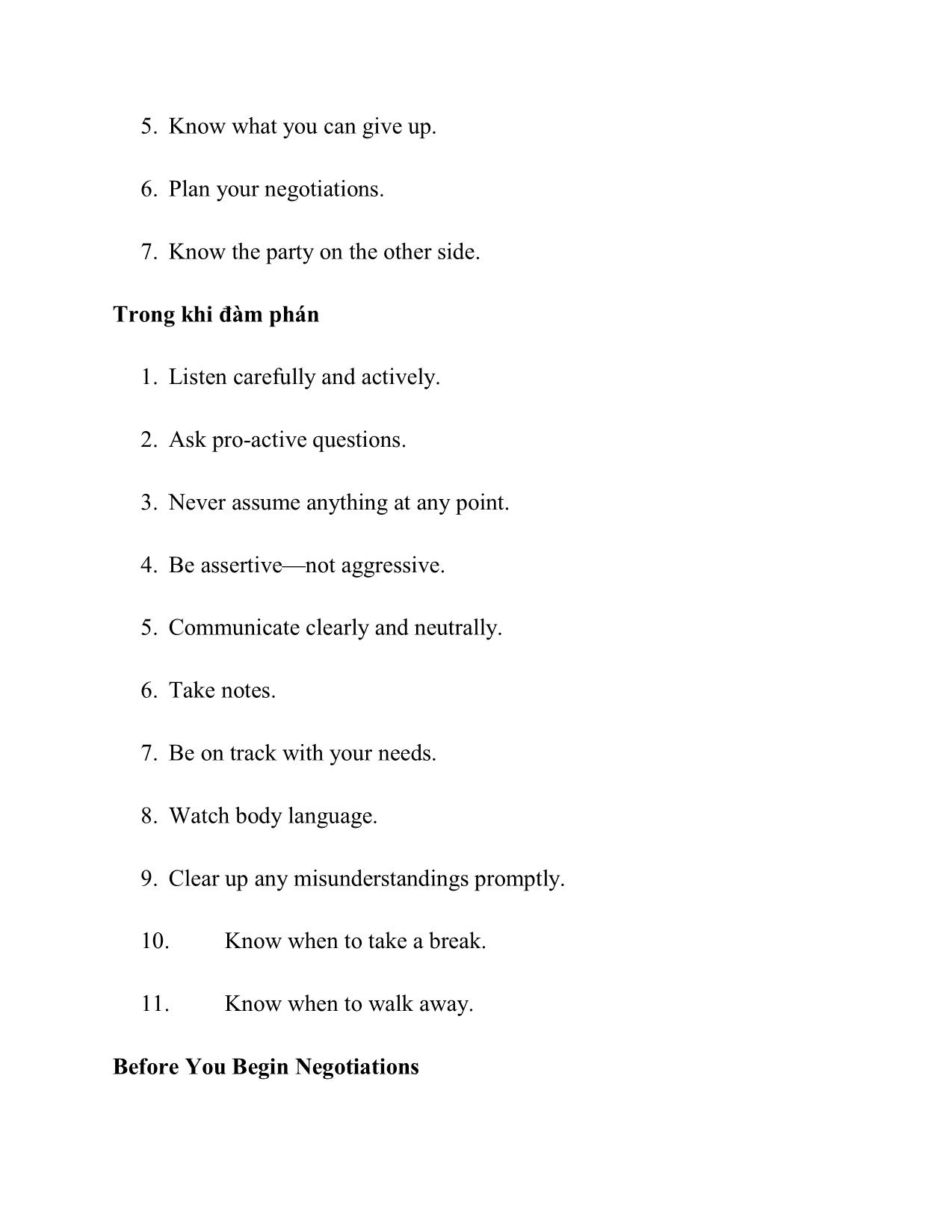
Trang 10
Tải về để xem bản đầy đủ
Tóm tắt nội dung tài liệu: Tài liệu Kỹ năng đàm phán của luật sư Quantcast
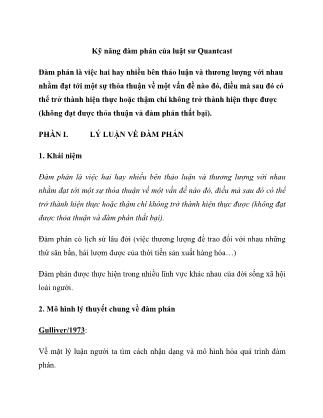
Watch body language. 9. Clear up any misunderstandings promptly. 10. Know when to take a break. 11. Know when to walk away. Before You Begin Negotiations When you license an online journal or database you must first ask yourself how you will be using this particular content in your library. Are you aware of your patrons’ needs and how will you go about ensuring that your patrons’ needs are met in your agreement? Sometimes it is helpful to put any legal agreement aside, and to write a list of all the things that you and your patrons might do with the journal or database. For instance, will you need to negotiate rights to print out certain parts of it, or email parts of it to yourself or to colleagues, or perhaps to copy it to a disk? Be prepared by having all the information you need. What do you want from the copyright-owner? Know what it is you want and how it will be used. It is a good idea to talk to others in your workplace to see how certain content will be used — will software be placed on six or eight computers? Will access to the online database be permitted only to staff or will the general public have access to the database? Will access be permitted off the library’s premises, and how about in other states or countries? What sorts of terms and conditions did you enter into last time with this copyright holder; how about with other copyright holders? Were those effective agreements or did they cause problems? For instance, under your previous agreements, were you only able to make a single copy of an article from the CD-ROM for each library patron or were you able to make class sets of 100? Preparation of your frame of mind is also an important initial task. Negotiation is not an “I-win-you-lose” affair. The content owner and yourself have the same thing in mind. You both want to enter into a relationship in which the content owner is fairly compensated for the use of its content while you have the right to use that content in the manners necessary for your situation (e.g., provide access to patrons, store in a digital form or distribute by email.) In a library setting, keep in mind who will be using the copyright-protected material and what they will be doing with this material. Will it be your patrons wanting to download information from your website? When negotiating with the copyright holder, discuss who will be allowed to use the material, how it can be used and what happens in the case of unauthorized use. Will fair use be covering the materials or will it be more restrictive? If you agree on something more restrictive with the copyright owner for your licensing agreement, then fair use is not open to you with respect to those materials. As a result, it is a good idea to negotiate with the copyright owner of the materials how your library’s patrons will be allowed to use these materials. Write down your goals so you do not get lost in the moment of the negotiation. Know what you want and need. There is a difference between what you want and what you need. You may want a Cadillac but you need transportation of some sort. If someone offers you the Cadillac at a price you can afford then go for it. But if that just is not going to happen and someone gives you a good deal on a K-car, be reasonable. Be prepared that you may not reach an agreement. Develop a set of alternatives for yourself. Is there someone else or another publisher you could approach for similar materials? How important are the materials to the library? It is important to have options available to you and these options may prove useful during your negotiations. Know what you can give up—for the right price. Always go to the negotiating table with a few items that you are willing to toss away altogether. They are called bargaining chips. They can be used to get something in return. Again remember the difference between what you want and what you need. For instance, are you willing to be flexible with delivery of the information or is this unacceptable for what you plan on doing with the materials? If you toss out one of these want items in exchange for a break on a need item, then you are ahead of the game. Know your price! How much are you willing to pay to license the materials? If the publisher wants fees based on the number of patrons, would they be willing to accept a pay-per-use model? What are you willing to give up and at what price? Do not just toss items to be agreeable. Use them and get something for them. Plan your negotiations—decide when, where, who and how. Setting the stage is important – even how the furniture is arranged can set the tone for the negotiations. For instance, one party sitting behind a big desk and the other party on the other side of it sets a much different tone from negotiating at a round table. Pick a place where you feel comfortable. If you feel better negotiating in your own office, choose this as the setting. If negotiations will take place in another setting, be sure to arrive fifteen minutes before your meeting. Get used to the surroundings. If you feel more comfortable with a mediator of some sort or an advisor, talk to the parties on the other side of the table and arrange for one. Note that negotiations need not take place in person, and may be done over the telephone or via email. Know the party on the other side. This does not necessarily mean personally (although that too could have its uses). Know the corporation or content owner you are dealing with. Have some idea of its background, its financial situation, where its interests lie. Does the company want to expand into a certain market or create a reputation in a certain area? Can you be the door that company uses to achieve those goals? If you are, then that may be one bargaining chip right there. Be sure that you are negotiating with the appropriate party. Negotiating with someone who has no real power in the organization or who cannot make the decisions you are asking them to make is a waste of time. Find out who the decision-makers are and talk to them. Make sure the party does indeed have ownership of the materials you want to license from them or that they have secured permissions from other copyright owners if necessary. During the Negotiations Listen carefully and actively. The opposing party could provide you with some information that you can use to your advantage. If you are unsure about something, ask for clarification so that there are no misunderstandings. Also, you should be sure that you understand exactly what it is you are hearing. Do not read something into what you are hearing and do not fill in gaps. Likewise, be careful not to miss anything that could turn out to be crucial. Ask pro-active questions that require more than “yes” or “no”. Information librarians are well acquainted with this technique. “Yes” or “no” answers tell you very little. You need information and clues as to where the negotiations are heading. Ask open-ended questions to get the other side to talk. Some individuals may be uncomfortable negotiating at all. If your are unable to get answers from the other party, perhaps changing the subject might be a good idea. For instance, if the other party is an artist, talking about the latest art exhibit might be a good way to get her or him to open up and then negotiations can proceed. Never assume anything at any point. If you are unsure about what you just heard–ask them to repeat it. If something appears to be missing, ask them why. It bears repeating–do not fill in gaps or read items into a statement that are not there. For example, if the other party says he wants to monitor how his copyright-protected materials is used, ask for clarification on how this is to be done and what sort of time and costs are involved. Be assertive (quyết đoán)—not aggressive. You have a right to expect co- operation in negotiations. You have a right to ask for items on your “want” and “need” list. But you do not have a right to bully. Aggression is not negotiation. Aggression will rarely get you anywhere–if anything it may cause the other party to walk away from the table entirely, realizing that you as a customer or partner are more trouble than you are worth. Do not be too dogmatic about your position—you are there to negotiate. Communicate clearly and neutrally. You are there as a representative of your library and do not have a personal stake in this negotiation. Neither does the party on the other side (usually). Do not compromise your own values and beliefs during the process. You are negotiating over a product, not a personality. Do not use doubletalk or veiled allusions in an attempt to stymie the other party. If you do have a personal stake in it, you might want a more objective person to conduct the negotiations on your behalf. Take notes. This is very important, particularly when the written agreement is presented for your approval. If something is missing or misrepresented then it is far easier to refer to your notes and bring it and them to the attention of the other party. Also, frequently check the notes you made while preparing for the negotiations. Make sure you are on track with your goals, and needs. If the negotiation takes place in person, watch their, and your own, body language. If on the phone, “listen” for intonations, and if by fax or email, look for any helpful signs in the language used to communicate. Clear up any misunderstandings promptly. Negotiations commence and continue under an aura of trust. Part of that trust involves keeping the other party’s goodwill. It is possible that innocent misunderstandings can destroy that aura of trust and finish your negotiations before they even get off the ground. Do not let misunderstandings get in the way of negotiations. Admitting that there was a misunderstanding is not a sign of weakness. Be honest. Do not bluff unless you definitely mean it. Bluffing does have its uses but be prepared to carry through on the bluff if the other party calls it. If your negotiations include discussions of licensing terms and conditions with which you are unfamiliar, take time to consult a lawyer or colleagues. Know when to take a break. Take some time during negotiations if things appear to be getting too heated. Take time if you have just been given a great deal of information to absorb. Take time if you need to consult with someone else. Ideas can come to you in the middle of negotiations that you need to have approval for before you act on them. The other party may toss out something on an unrelated matter that gives you some additional insight. Most importantly, take some time to think over the deal before closing it. A Final Tip Lastly, know when to walk away–and do it. Do not be afraid to walk away from the negotiations if the negotiations are going nowhere. If you are not reaching your goals, then further negotiations are a waste of your time and theirs. Sometimes minds just cannot meet in the middle. Your time would be far better spent looking for another supplier that may meet your needs. Now is the time to consider the alternatives to your negotiated agreement. PHẦN THỨ III VAI TRÒ CỦA LUẬT SƯ TRONG THỰC TIỄN ĐÀM PHÁN Ở VIỆT NAM 1. Những vấn đề chung Thực tế thì vài trò của luật sư chưa cao. Được sử dụng nhiểu hơn trong giải quyết tranh chấp Được sử dụng hoặc là người đại diện hoặc là trung gian hòa giải 1. Đàm phán nhằm thiết lập quan hệ hợp đồng Luật sư với vấn đề đàm phán hợp đồng cung cấp dịch vụ của chính mình Hầu như không được đề cập trực tiếp trong bất cứ tài liệu nào nhưng lại là việc mà luật sư nào cũng phải làm. Thực tế diễn ra như thế nào? - Đàm phán thường gồm 02 giai đoạn: Đàm phán trực tiếp với khách hàng về những điều kiện cơ bản của việc cung cấp dịch vụ và đàm phán về các điều khoản của hợp đồng cung cấp dịch vụ - Giai đoạn 1: phạm vi cung cấp dịch vụ – giá cả – thời hạn - Giai đoạn 2: các điều kiện và điều khoản cụ thể - Cũng không loại trừ việc khách hàng yêu cầu gửi trước bản chào cho họ và sau đó là công việc đàm phán trực tiếp, còn việc thể hiện kết quả trên hợp đồng được coi là công việc kỹ thuật mà thôi. - Một số kinh nghiệm sử dụng các thủ pháp kỹ thuật trong đàm phán: First Offer – Large Demand; Whipsaw; Concession and Compromise; Splitting the Difference; Negotiation without Authority; Take break and Walk away. Luật sư với vấn đề đàm phán hợp đồng cho khách hàng của mình Khác với các nước, ở Việt nam luật sư chưa được sử dụng làm người hướng dẫn đàm phán. Công việc đàm phán mặc dù được coi trọng nhưng không được thực hiện một cách bài bản của các doanh nhân. Việc đàm phán thường được coi là công việc riêng của doanh nghiệp không phải của luật sư. Luật sư chỉ đóng vai trò là người gác gôn về mặt pháp lý mà thôi, trong khi đó vấn đề pháp lý lại được xem là vấn đề kỹ thuật và thường được biến thành việc trao đổi giữa các luật sư của hai bên vào giai đoạn cuối. Một số ngoại lệ: Soạn thảo hợp đồng – cùng tham gia đàm phán – hoàn thiện hợp đồng; Những việc luật sư có thể làm và nên làm đề giúp ích cho quá trình đàm phán: 1. 1. o Tư vấn trong việc lập kế hoạch đàm phán – lưu ý cách đặt vấn đề o Tư vấn về việc áp dụng thủ pháp kỹ thuật đàm phán o Cảnh báo trước những vấn đề bất lợi o Lưu ý những giới hạn về pháp lý 2. Đàm phán giải quyết tranh chấp hợp đồng Thực tế luật sư được nhờ không phải do giỏi giải quyết tranh chấp mà là trong lúc khẩn cấp khách hàng cần đến sự hỗ trợ về mặt pháp lý. Dù làm đại diện hay trung gian hòa giải, những công việc mà luật sư nhất thiết phải làm gồm: o Tìm hiểu thật kỹ sự việc và diễn biến sự việc cho đến thời điểm mà mình được nhờ o Trên cơ sở đó, dự tính khả năng thành công và mức độ thành công; dự tính phương thức giải quyết vấn đề và thảo luận với khách hàng của mình o Tìm cách khai thác tối đa điểm yếu của đối phương để đạt được một thỏa thuận khả quan nhất; xây dựng phương án đàm phán phù hợp o Tổ chức triển khai phương án đàm phán đã được chuẩn bị sẵn o Lập biên bản ghi nhận kết quả và làm căn cứ theo dõi việc thực hiện Vấn đề sử dụng thủ pháp kỹ thuật trong đàm phán giải quyết tranh chấp hợp đồng o Reasonable Elaboration (tiên lễ hậu binh) o Threat o Concession and Compromise o Splitting the Difference o Take it or Leave it (Boulwareism) – thủ pháp được đặt theo tên của một nguyên Phó chủ tịch tập đoàn General Electric, là người khởi xướng thủ pháp này. Lưu ý: Việc áp dụng các thủ pháp là rất khác nhau tùy theo tính chất và mức độ của tranh chấp và điều kiện, hoàn cảnh cụ thể của thân chủ.. Phân tích qua một số ví dụ. (SUN LAW FIRM st)
File đính kèm:
 tai_lieu_ky_nang_dam_phan_cua_luat_su_quantcast.pdf
tai_lieu_ky_nang_dam_phan_cua_luat_su_quantcast.pdf

